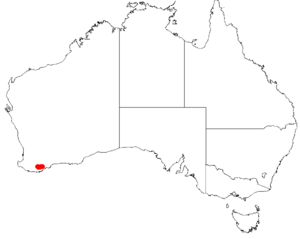Wittwer's darwinia facts for kids
Quick facts for kids Wittwer's darwinia |
|
|---|---|
 |
|
| Darwinia wittwerorum in Kings Park Botanic Garden | |
| Conservation status | |
| Scientific classification | |
| Genus: |
Darwinia
|
| Species: |
wittwerorum
|
 |
|
| Occurrence data from AVH | |
Darwinia wittwerorum, also known as Wittwer's darwinia, is a special plant in the myrtle family. It is only found in a small area of Western Australia. This plant is a tall, thin bush with small leaves. Its flowers hang in groups and are surrounded by special leaf-like parts called bracts. It is one of the plants known as 'mountain bells'.
Contents
About Wittwer's Darwinia
Wittwer's darwinia is a tall bush with one main stem. It usually grows about 60 to 80 centimeters (2 to 2.5 feet) tall. Its leaves are spread out along the branches. They are thin and straight, like tiny needles. Each leaf is about 5 to 10 millimeters long (less than half an inch) and very narrow.
Flowers of Wittwer's Darwinia
The flowers of this plant hang in groups of 5 to 9. They are surrounded by large, leaf-like parts called bracts. The inner bracts are shaped like eggs. They are about 18 to 21 millimeters long (almost an inch). These inner bracts are partly cream and partly pink. The outer bracts are cream-colored and thin.
The flowers themselves are cream-colored. Each flower has ten stamens, which are the parts that make pollen. It also has a style, which is a stalk with a brush-like tip. Wittwer's darwinia blooms from August to November.
Where Wittwer's Darwinia Lives
This special darwinia plant is currently found in only eight small groups. These groups are located in the lower part of the Stirling Range in Western Australia. It grows in open areas with small trees and bushes.
Protecting Wittwer's Darwinia
Darwinia wittwerorum is a very rare plant. The Western Australian Government lists it as "Threatened Flora." This means it is a rare plant that needs protection. A plan has been made to help it survive.
The Australian Government also lists it as "Endangered" (EN). This is because the plant's living areas are broken up into small pieces. It also has a very limited area where it can grow. Protecting this plant helps keep Australia's unique plants safe.


